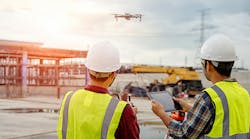OSHA is stepping up its use of drones to inspect worksites. As it does so, the practice places employers in an uncomfortable position between the proverbial rock and a hard place.
Should you give OSHA permission to use drones on your property not knowing what they will find, or withhold consent and look like you have something to hide?
We first reported on the practice when the news surfaced late last year that the agency had put procedures in place for the use of these unmanned craft as another tool in the inspection process. OSHA reportedly used drones with cameras to conduct at least nine inspections of employer facilities in 2018, and has conducted an additional nine such inspections so far this year.
As of now, OSHA has used drones only with employers’ permission, at worksites where an accident occurred and the area was considered too dangerous for inspectors to enter (such as collapsed buildings, chemical fires and oil rigs).
We can expect greater use of drones for this purpose in the future, according to Wes Gerrie, an attorney with the law firm of Goldberg Segalla LLP. “With the increased prevalence of drones in day-to-day life, one can only expect that number to increase.”
Currently, it is up to the OSHA regional administrators to determine whether their region will act to institute a drone compliance inspection program. Any region wishing to do so must establish a regional drone program manager and organize a drone inspection team consisting of a remote pilot in command, visual observer and a safety monitor.
The visual observer must be an OSHA employee and the pilot makes all flight determinations. The program must also comply with all Federal Aviation Administration (FAA) regulations, including strict registration, certification and reporting. Finally, the pilot must always maintain line-of-sight with the drone and the team must notify all people on-site before a flight.
One of the most obvious tensions created by these procedures arises when an OSHA drone inspection runs up against a business’s protections against unauthorized searches, Gerrie points out. “While such an issue will likely be heavily litigated in the future, OSHA currently requires employer’s consent before conducting a drone compliance inspection.”
OSHA currently is seeking a blanket public certificate of waiver/authorization from the FAA to use drones anywhere in the country without requiring consent, Gerrie reports. But at present, the agency can only conduct a drone compliance inspection with the consent of the employer, keeping some control within the hands of the business entity subject to the inspection.
Consent a Double-Edged Sword
At this time, if an employer consents to drone inspections by OSHA, it should continually monitor the drone flight, and make sure that compliance takes place in regard to both the FAA and OSHA’s own policies and regulations, and that the consented-to flight plan is consistently adhered to.
“Notably, an employer can refuse such an inspection,” Gerrie says. “However, as a practical matter, it may create the appearance of impropriety and such a decision should be considered carefully.”
If you are approached by OSHA regarding a potential drone inspection, Gerrie stresses that it is important to consider these points:
● The definition of “in plain view” is greatly expanded by drone use. Where previously, an inspector may have to look through a fence or even from outside the property for an apparent violation, a drone can reach and see other areas, making a larger portion of the worksite available for inspection.
● While denying a request for drone inspection may create the perception of a compliance issue, in serious injury cases (such as a loss of limb or fatality), it may be important to consider denying the request until the safety officer, legal counsel and senior management can get on site.
● Drones flying over a worksite may inadvertently capture trade secrets or Environmental Protection Agency (EPA) violations, which may be shared between agencies or be available via Freedom of Information Act requests.
● Before consenting, an employer should consider the site itself and whether a drone flight would be safe or risk causing damage to equipment or work products.
● An employer can work with OSHA on developing a specific flight plan and get copies of the data collected.
● During a typical OSHA inspection, an agent of the employer usually accompanies the inspector, which is not possible during a drone flight.
Given these considerations, Gerrie suggests that the conventional approach of simply allowing OSHA to inspect a site may be turned on its head in favor of an employer requesting that OSHA provide a warrant first.
“Should the employer provide consent, it is extremely important that the employer and OSHA agree upon a specific flight plan and that each of the above bullet points are discussed and considered within the flight plan,” he recommends. “Further, it may be prudent to consult with legal counsel when agreeing to a specific flight plan.”

